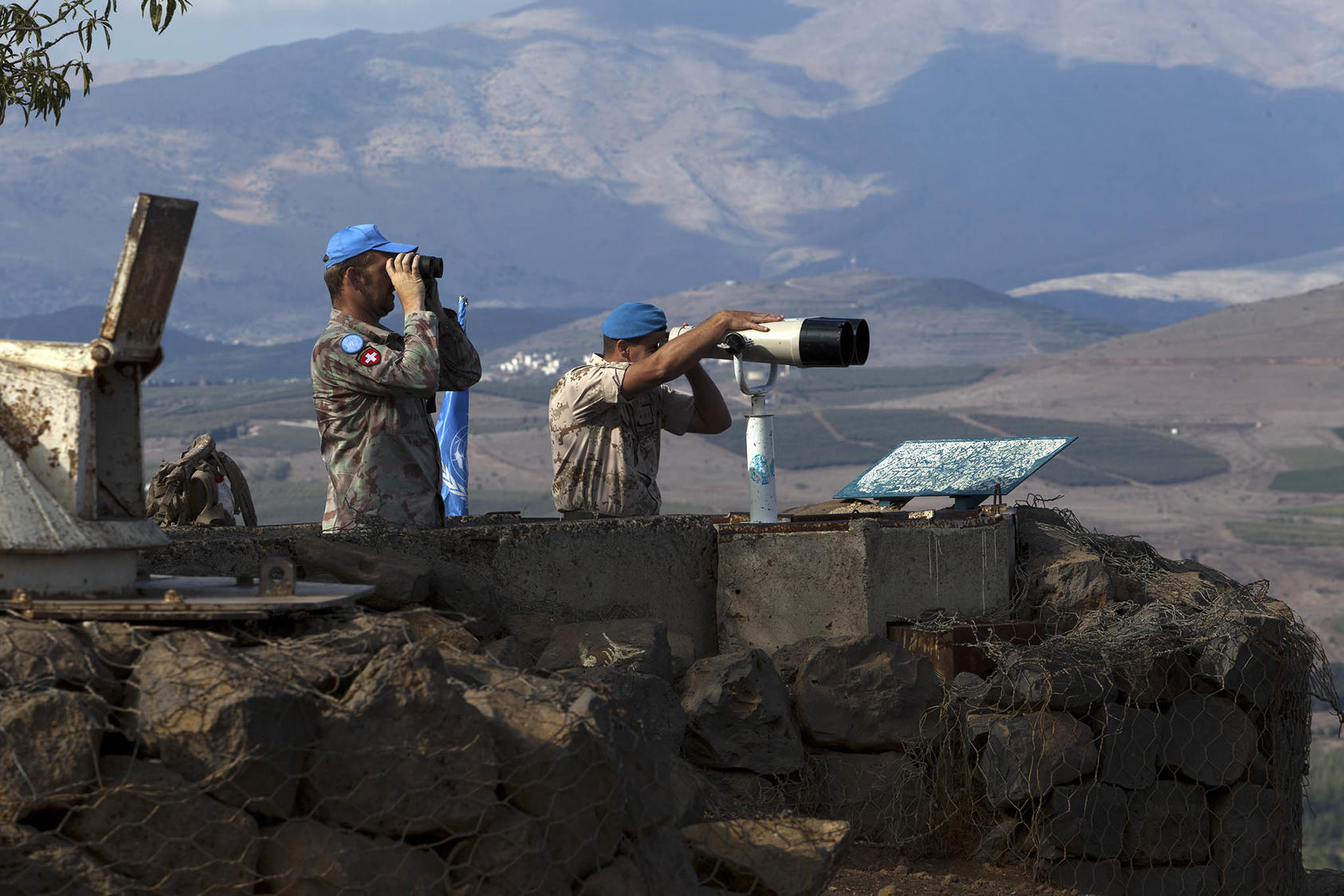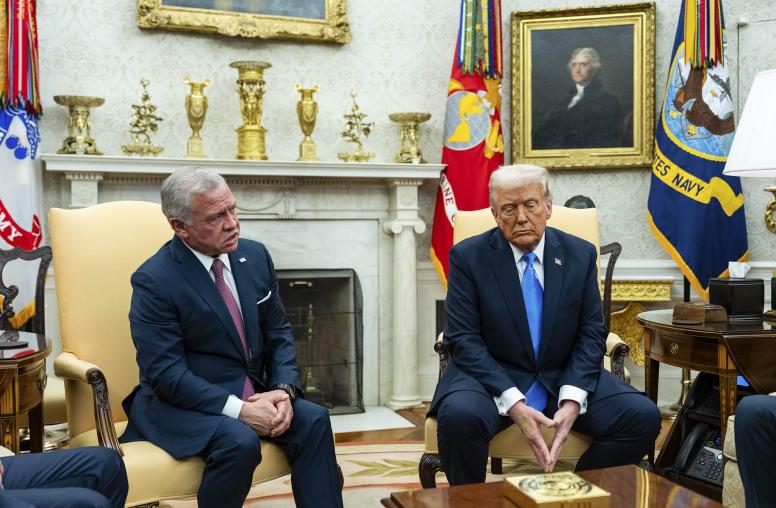Could Syria Have Been Saved by a U.S. Effort to Bring It to Peace with Israel?
Weeks before the Assad regime began its brutal campaign of violence, a U.S. diplomat was closing in on an Israel-Syria peace deal.
Over a decade into Syria’s civil war, it’s hard to fathom the country at peace and integrated with the international community. The Assad regime’s brutal oppression of protests in March 2011 sparked more than 10 years of violence, conflict and tragedy in the country. But in the weeks before, there was quiet hope that a clandestine U.S. effort could broker a land-for-peace deal between Israel and Syria. For Syria, such a peace agreement would have resulted in the lifting of U.S. sanctions and financial assistance, trade and investment from the international community, giving Syrians hope for a better future.

Back in 2009, the Obama administration dispatched an experienced team, led by the venerable negotiator and former senator, George Mitchell, to forge peace between Israel, the Palestinians and the broader region. As part of that effort, Frederic Hof was leading secret talks on an Israel-Syria track. This is the story he tells in his new USIP book, Reaching for the Heights: The Inside Story of a Secret Attempt to Reach a Syrian-Israel Peace.
In an interview with USIP, Hof discussed what an Israel-Syria peace agreement would have looked like, how the events of the Arab uprisings scuttled his mediation efforts and President Biden’s visit to the Middle East amid new strategic alignments emerging in the region.
Trying to Get to Israel-Syria Peace
The concept of land-for-peace may seem straightforward enough: Israel would withdraw to the June 4, 1967 line, thereby returning the parts of the Golan Heights it captured in the 1967 war, in exchange for Syria’s strategic realignment away from Iran, Hezbollah and, most importantly, Hamas. But even mere meters of territory could be a stumbling block. As Hof details in the book, Israeli leaders feared that they would be unable to rally public support behind the return of the strategically important territory and Syrians indicated their unwillingness to accept anything but a full Israeli withdrawal to the June 1967 line.
By the fall of 2010, Hof had reached an agreement with Israelis and Syrians on a methodology for moving this complex mediation effort forward. He drafted a treaty and then began shuttling back and forth from Jerusalem to Damascus to iron out the details.
A leading expert on the precise details of the June 1967 line, Hof said he “mastered the brief” on the complexities of the situation. In 2009, he wrote a USIP report laying out the contours of what Israel-Syria peace would look like. His facility with the issues at hand undoubtedly aided his ability to mediate between the two parties.
“My ability to get anywhere with these parties was premised on the proposition … that I probably knew more about the territorial aspects of an eventual settlement than [Israeli and Syrian leaders] did,” Hof said at a recent USIP event.
In a face-to-face meeting with Assad at the end of February 2011, Hof received assurances that the Syrian leader understood that he would need to move away from his alignment with Iran, Hezbollah and Hamas.
For Israel, a land for peace swap was not enough to engage seriously in talks with Syria. Hof said he believed Israeli Prime Minister Benjamin Netanyahu was engaging on the Syria track only as a way to avoid the question of Palestine: “It was only when [top National Security Council staffer] Dennis Ross and I were able to convince Netanyahu that there was a possibility that Syria would shift its strategic alignment away from Iran, Hamas and Hezbollah that got Netanyahu to think about it more seriously.”
Hof left the meeting with Assad feeling optimistic about where his mediation was heading. But he still had reservations. “The one thing that troubled me considerably … was my reflection on Assad’s assertion that Iran and Hezbollah would immediately fall into line if he reached a peace treaty with Israel,” Hof said
Nonetheless, Hof relayed to Netanyahu that Assad had agreed to Syria’s strategic reorientation. “Ok this is serious,” Netanyahu said to Hof. “What do we do next?”
Assad, Syria’s Uprisings and the Collapse of Peace Talks
By that time, though, uprisings were embroiling the Arab world. Protesters in Tunisia and Egypt had overthrown the old dictators that had ruled with an iron fist for decades, inspiring legions of people around the region to call for change.
Indeed, regional developments likely compelled Assad to engage seriously in Hof’s mediation efforts. “Assad had the view that to get out from under American sanctions and to boost Syria’s economy in a way that benefited him domestically, he’d have to make peace with Israel,” Hof said. Beyond shoring up his political legitimacy, a peace deal with Israel would have also meant the lifting of U.S. sanctions in parallel with Assad meeting stipulations that Syria strategically reorient its security posture, opening the door to financial assistance, trade and investment.
Then on March 18, Syrian security forces opened fire on demonstrators in the southern Syrian city of Daraa, who were protesting the abduction and torture of teenagers who had graffitied anti-Assad messages. This was the beginning of Syria’s uprising that devolved into a decade-long civil war and the end of Hof’s mediation effort.
“[A]t the beginning of March 2011, the foundation for Israel-Syria peace had been set,” Hof wrote. “By the end of that month, it would be cratered.”
A British-educated ophthalmologist, Assad came to power at the age of 34 following the death of his father, the wily Hafez al-Assad, with hopes that the young leader could be a “modernizer of sorts,” said Hof. He had, for example, worked to install a modern banking system in Syria and opened political space in the country, albeit slightly. Whatever hopes had remained after Assad’s decade in power were dashed after the events of March 2011. Today he is one of the “21st century’s leading purveyor of crimes against humanity,” Hof said.
As the violence and chaos in Syria unfolded, Hof wondered if Assad believed that his engagement in peace efforts would provide him cover for the heinous crimes he was inflicting on Syrians. “I feared Assad’s misunderstanding of how the United States and Israel would process Syrian state terror,” Hof wrote. Wondering if Assad could be persuaded to stop his campaign of violence, Hof suggested that a call from President Obama to Assad — or another one-on-one with him and Assad — warning him that unless the shooting stopped U.S. peace mediation would end, might save the peace process and Syria from its descent into chaos. Ultimately, Obama declined to reach out to Assad personally or have another member of his administration do so, in part due to domestic political considerations.
It’s impossible to know if a call from Obama could have saved U.S. mediation efforts. But, for Hof, it was worth trying. On the other hand, we do know where Syria is today.
The statistics paint a grim picture. More than half of Syrians have fled their homes, with 6.9 million internally displaced and 5.6 million refugees abroad. Of the country’s 22 million people, 14.6 need humanitarian assistance, with 12 million struggling to eat every day. Syrian civilians have been subjected to unspeakable war crimes, like torture, rape and starvation. The United Nations has recorded the deaths of over 350,000 civilians and combatants but warns that number is certainly an undercount. While the Assad regime controls the majority of the country, a patchwork of jihadist forces, Kurdish fighters, Turkish-based rebels and others hold sway over small pockets of Syria.
“At the time, I honestly thought that [an Obama call to Assad] might have less than a 50/50 prospect of success. But I thought it was absolutely essential to try. And here we are over 11 years later, and Syria is in a state of wreckage,” Hof lamented.
Syria and the New Middle East
After a decade of being a pariah propped up by Iranian and Russian support, there is a gradual warming of relations with Assad in the region. In March, Assad made his first trip to another Arab nation since 2011, visiting the United Arab Emirates (UAE). Bahrain named an ambassador to Syria late last year, the first time the Gulf country has had one in over a decade. Relations with other Arab countries like Jordan, Egypt, Lebanon and Saudi Arabia are also slowly on the mend. Damascus is set to host an Arab energy conference in 2024.
This follows what USIP’S Mona Yacoubian, an expert on Syria, has called “a dynamic of de-escalation” in the region, evidenced by Israel’s normalization with Gulf States and the recent efforts by archrivals Saudi Arabia and Iran to reduce tensions. This trend is driven in part by a sense among some in the Middle East that the United States is looking to retrench its role in the region, said Lucy Kurzter-Ellenbogen, who leads USIP’s Israeli-Palestinian conflict program.
“If there is this trend, I do not see personally how normalization with Assad works into it,” Hof said. “Assad is absolutely devoid of any political legitimacy inside Syria.”
With President Biden in the Middle East this week, Hof said that the United States should press the UAE, which has been at the forefront of warming relations with Assad, to explain why it is seeking to build ties. “My recommendation would be simply for the U.S. government at a sufficiently high level to ask the Emiratis: What are you getting in return for normalization with Assad? What exactly have you gotten? Because what you are giving is something of great importance to the president of Syria.”
Biden has received significant criticism for visiting Saudi Arabia after pledging during the 2020 presidential campaign to make the Kingdom a “pariah.” But Hof sees value in the president’s visit. ”I think what President Biden is trying to do is, at the very least, symbolically very important” because the idea that Washington “intends to jettison its position in the region” can have “very bad effects in terms of regional peace and stability,” Hof said.



